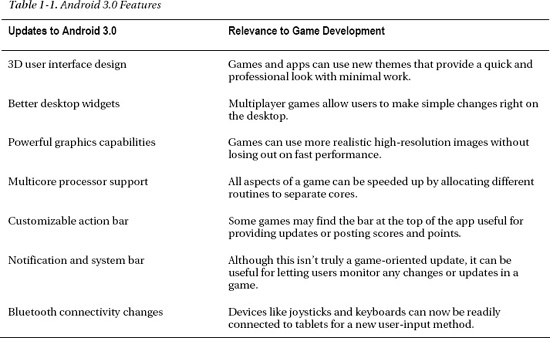What Is Android?
Android is very special, and you’ll gain much more appreciation for it as you get into the programming. The movement of many handset makers to create tablets running the Android OS created a huge market for the games you’ll make. This section gives you a rundown of Android’s features and history.
The Beginnings of Android
In 2003, Android began as a small Silicon Valley startup company with the aim to create a more interactive and helpful interface for smartphones. Google quickly snatched up the company in 2005 as part of its push to enter the mobile phone market. After Google acquired it, the first Android OS was soon released during 2007. In subsequent years, Android went through many revisions (more than seven major changes) that made it one of the leading operating systems for smartphones, with some saying that Android has nearly 50% of mobile devices.
The revisions to Android are very important to understanding how development works. Google worked hard to ensure backward compatibility in its version of Android; however, applications generally are designed to work for a select couple of Android editions to guarantee the best performance and user experience. The version called Froyo is still the most popular for developers, but the later versions are gaining steam as more modern devices like tablets require more powerful operating systems.
The following list of Android versions, along with their current market share, illustrates which versions remain popular and therefore are of interest to developers. The creative name given to each version by Google is next to the edition number. Developers often go by these names rather than merely the numbers. Keep in mind that with the exception of Android 3.0, all versions of the OS were designed for phones exclusively:
- Android 1.5 Cupcake (2.3%)
- Android 1.6 Donut (3.0%)
- Android 2.1 Éclair (24.5%)
- Android 2.2 Froyo (65.9%)
- Android 2.3 Gingerbread (1.0%)
- Android 2.3.3 Gingerbread (3.0%)
- Android 3.0 Honeycomb (0.3%)
If you’re interested in checking the current market share of the various versions, go to http://developer.android.com/resources/dashboard/platform-versions.html.
After examining this list, many would say that you should be making games for Froyo because it has a huge lead in market share over other versions. The reason for Froyo’s prevalence is that it’s installed on many simpler older phones that can only get updated versions through a complicated process. These devices will slowly become inconsequential as the newer versions take center stage. To some extent, making games for the majority of users makes sense; however, every day new users are buying more modern phones that use the later versions. Also, perhaps the most important point is that hundreds of thousands of apps are playable on the Froyo version, and it’s increasingly difficult to stand out.
With that being said, this book teaches you to designs games for the latest edition (Honeycomb) for two reasons. First, Honeycomb is the only version optimized for tablets, which are much more immersive and fun than any smartphone. Second, Android tablet computing is growing at a huge rate as more companies release tablets that can compete with Apple’s iPad. With the failure of webOS, Android and iOS are the only contenders in the tablet market. Microsoft has also come out with its own operating system, but it has not yet garnered significant market share. Google’s often-quoted statement about 500,000 Android devices being registered each day gives you a sense of how fast this market is expanding.
Android 3.0 Features
Honeycomb is a huge advance from the previous Android versions. Designed to utilize a much larger screen and more powerful processor, Android 3.0 lets developers expand their usually modest smartphone games. Many of the new features are user-interface changes that make the desktop accessible to users with a screen that is several times bigger than a smartphone screen. For example, typical phones have two- to three-inch screens, whereas tablets boast impressive nine- to ten-inch screens. These updates are convenient; however, game developers concentrate more on the updates to speedier graphics rendering and the new sensors and network abilities of the operating system.
Not all games use all of these features, but it’s crucial to consider their importance in designing unique games. The larger screen is in itself an update worth noting. The high-resolution screens demand artwork that is scalable and visually appealing. Many Android tablets have landed on 1280 × 800 as their screen size. This is comparable to the resolution that many computer screens still use. In this case, the graphics must approximate the images used in computer games.
Table 1-1 list major changes to Android 3.0 of particular interest to game developers.
Throughout the book, I give advice about how to make the most of the new Android tablet features. If you’re looking to make games as a hobby by yourself, then watch for my notes about where to get quality sounds and images royalty-free. The tools I use for making music and graphics for my games are also explained in depth later in chapter 2.
I hope that after getting acquainted with Android, you’re ready to get started. Read the next section carefully, though, to ensure that you have the proper skills and hardware to develop games for Android.

